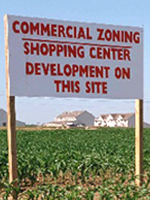
Sloan, Robert "Bobby"About | Story: Where Have All the Farm Fields Gone? | Abstract AboutThe interview is about the cycle observed over a one-year period of farming.
Story: Where Have All the Farm Fields Gone?
Robert Sloan: The pecan industry's pretty big, so, you've got the pecan farms. That segment has probably bought up quite a bit of land and probably done the most of anybody farmin' right now lately. Houses are probably right in there with the pecan farmers as taking the next chunk of land. You know, percentage of the guys that maybe farm less acres, and they farm a little more high-dollar crops, in other words, your vegetables, I mean lettuce, chiles. My neighbor right here, pine trees is his main deal, and he doesn't farm a lot of acreage, but it's pretty high dollar, pretty intense what he does have to farm. And then the balance of the land is pretty well, kinda caught out here at this time, in no man's land. Most of this land is going to be up for sale or something here in the next, you know, it's hard to say. As people pass away, most of this land is gonna be sold. Some of 'em manage to hang on to it, but most of it they wind up selling it. That type of land that's in that situation, you wind up seeing more, the guys that farm that kinda land with cotton and alfalfa and corn silage, those types of crops are not really high dollar crops, but they kinda fit in the mix there. Beth Morgan: Do you feel like this area is threatened with development? RS: Yeah, I mean anybody that's been around here very long, the urban sprawl's pretty obvious, and there's not really a whole lot anybody can do. There's several plans on trying to retain some of the farmland as agriculture, but I haven't seen anything that's really looks like it's gonna work. It turns out to be a matter of your right, and money and people wanna have, retain their right to get all the money they can out of their land, and so that's a tricky deal. But see, I think the farmland here's shrinking a little bit every year. Abstract
Tape 1, Side A
Robert Sloan, a fourth-generation farmer in the La Mesa area, describes the nature of his farm. It is made up of several plots north and south of La Mesa. This is common, as pecan farms and housing developments have large land holdings in the area. It is primarily rented ground and comprises about 1,400 acres, a little more than average for the area. The trend is for farmers to expand the acreage they plant when an older farmer retires and the resulting surplus of agricultural land must be picked up by other farmers. Some vegetables-lettuce, onions, and chile-are raised in the valley but Sloan is among those who raise mostly cotton, corn for silage, and alfalfa. Irrigation is the flood type-from canals distributing water provided by the Elephant Butte Irrigation District (EBID). Distribution usually begins in March. Farmers must place orders for the water to irrigate their crops, which usually is delivered within three days. Adjudication of water rights along the Rio Grande is ongoing. Farmers hope their documented beneficial use of water will ensure their continued right to it. Some secondary canals may be used to get the water from EBID canals to the parcels requiring it, only a little is piped to fields and a small portion, due to elevations, must be pumped up to the fields. Soils in the area vary greatly because much of it used to be river bottom, from sandy soil that doesn't hold nutrients well, to heavy clay. The soil type helps determine what will be planted: alfalfa does well in sandy soil, but not in clay. Cotton or corn does better there. Sloan likes to decide what crops he'll grow in November/December, but it's not always possible to decide that early. Sometimes it's as late as March/April because fluctuating markets for commodity crops keep farmers guessing until later in the season which crops would be most profitable in a given year. Alfalfa, however, he plants in the fall on land that requires crop rotation. And while a certain amount of preparation of soil is necessary for cotton or corn-which it will be can be decided at the last minute.
Tape 1, Side B
Knowing what to plant is certainly desirable by January if financing is required. Cotton and corn are commodity crops. What rotation requires and profitability are deciding factors. Row crops (i.e, cotton and corn) are planted first, then alfalfa in early spring or in the fall. Several steps are required to prepare ground for cotton-which probably would have been harvested around December 1st-shedding stalks, destroying existing beds, tilling, smoothing and preparing new beds by March 1. Then the ground to be planted in cotton would be pre-irrigated. Then, more tillage to loosen up the ground; this is for cotton or corn. For corn, when it is planted depends in part on the schedule of the custom processors (who chop it for silage). Those dates are negotiated based on when they are committed to other farmers. Corn is planted probably in April sometime-cotton depends more on the weather, anywhere from early April to early May, when the soil is warm enough. Corn and cottonseed are largely commercially acquired. Corn seed may come from Arizona or the Midwest. You can get the seed from cotton that has been processed locally, but that's not common practice anymore. Some fertilizers, herbicides, pesticides will be applied before planting. Sloan does this, but will also reapply fertilizer and herbicides after the plants are up, especially for corn and cotton. Alfalfa is different, being flat planted. It gets a one-time application in the spring. Sloan plants about eighty percent of his acreage in cotton and twenty percent in corn. Cotton may not be watered until mid-June, after which it blooms and puts on fruit. Cotton can go up to ninety days before the first post-planting irrigation. Corn would need water about thirty days sooner. Then, corn would need water about every ten to fourteen days and cotton every fourteen to twenty days. Herbicides and cultivation are used to control weeds. It's a "four-pronged attack": rotation, herbicide, cultivation, and as a last resort, hand labor. On cotton, it would probably be cultivated about a month after planting and then ten days later.
Tape 2, Side A
Corn grows faster. It might be cultivated a couple of times after it comes up and a third time when it is about two to three feet tall. Cultivation, along with eliminating weeds, helps to aerate the soil. Sloan will continue cultivating cotton through the end of June, when it has become too tall to use for the tractor in the fields. He may apply a herbicide in early July. Cotton needs more pest control; it usually even gets some before planting. Lygus is a problem early in the season. Corn is not affected as badly by insects. Lygus may move from alfalfa or other crops into cotton. It feeds on the little fruiting forms, of which there are only so many. If you lose a significant number of those, your yield will be reduced. Mid-season bollworm will eat the cotton fruits and late season pink bollworm can harm the fruits. A scouting program will help determine the presence of pests and an estimate can be made regarding economic damage. Each pest may require a separate chemical, probably either an organophosphate or a pyrethroid. Insect pressure is not as heavy here as in some other areas, so they may only have to treat it once or twice in a season. Boll weevils were introduced from Texas about four years ago. Malathion was used to control this infestation. This past season, only one thousand acres were treated for boll weevil throughout the valley. If this program is continued, it is hoped that the boll weevil will be eliminated from the area by next year. Alfalfa may have weevils and aphids. It's usually treated only once in the spring—probably with Lorsban. Harvest—cotton harvest begins late September/early October and finishes early December—if the weather is good. It is picked by machine and loaded into trailers or modules. The corn is harvested by contractors. They usually want it to be about seventy percent moisture, and when they pack it, it removes the oxygen, promoting fermentation. It makes ensilage, a nutritious food for cattle. While farmers might prefer to grow wheat or barley, corn for silage is one of the few crops that is profitable to rotate with cotton. Alfalfa is a longer-term commitment than corn. It generally is sold to local dairies. Corn is harvested late July through August. If double-cropped, maybe not until late August into October. Corn matures in ninety to one hundred and twenty days, thus, if planted in April, it'll be harvested in August. You may then plant that ground in alfalfa or vegetables. Usually alfalfa is harvested mid-October through early November, but could continue into December. Technology—bigger more sophisticated farm equipment allows fewer people to farm more acres. This is the biggest change he's seen in agriculture in his lifetime. This has had an impact on demographics. Many small rural towns that once supported local agriculture have been deserted, as a result. We'll always have to have equipment operators and some hand labor. But not very many people want to do hand labor. There's no Bracero program and hasn't been one for years. If you're a Mexican national without papers, you're not supposed to work here. Sloan sees the greatest pressures on farming right now and into the future as development and commercialization. Since it is difficult to make money on most crops without significant volume, he sees the small farms decreasing in numbers and farmland turned over for housing subdivisions. The pressure on water sources is also a concern—partly because of the current drought and partly because water rights are still being adjudicated. His farming is cyclical, and changes with the seasons, what is required at a given time. After a year's cycle of farming, it starts all over again. |

